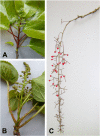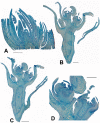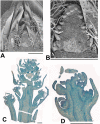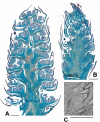Evolution of Catkins: Inflorescence Morphology of Selected Salicaceae in an Evolutionary and Developmental Context
- PMID: 26697024
- PMCID: PMC4671327
- DOI: 10.3389/fpls.2015.01030
Evolution of Catkins: Inflorescence Morphology of Selected Salicaceae in an Evolutionary and Developmental Context
Abstract
Poplars (Populus sp.) and willows (Salix sp.) are well known woody plants common throughout the northern hemisphere, both with fully sequenced genomes. They bear compact unisexual inflorescences known as "catkins." Closely related genera of the "salicoid clade" within the family Salicaceae include the Asian genera Bennettiodendron, Idesia, Itoa, Poliothyrsis, and Carrierea and the Central American genera Olmediella and Macrohasseltia. Like willow and poplar, most of these genera are dioecious, but unlike willow and poplar they generally have loosely branched panicles rather than catkins, and less highly reduced flowers. However, the early developing inflorescences of Carrierea and Idesia show similarities to catkins which suggest possible pathways by which the salicoid catkin may have evolved.
Keywords: dioecy; floral reduction; genome-enabled model system; heterochrony; inflorescence architecture; inflorescence evolution; preformation; synorganization.
Figures







Similar articles
-
Frequent ploidy changes in Salicaceae indicates widespread sharing of the salicoid whole genome duplication by the relatives of Populus L. and Salix L.BMC Plant Biol. 2021 Nov 13;21(1):535. doi: 10.1186/s12870-021-03313-x. BMC Plant Biol. 2021. PMID: 34773988 Free PMC article.
-
Plastome phylogeny and lineage diversification of Salicaceae with focus on poplars and willows.Ecol Evol. 2018 Jul 13;8(16):7817-7823. doi: 10.1002/ece3.4261. eCollection 2018 Aug. Ecol Evol. 2018. PMID: 30250665 Free PMC article.
-
An extinct genus of Salicaceae based on twigs with attached flowers, fruits, and foliage from the Eocene Green River Formation of Utah and Colorado, USA.Am J Bot. 2003 Sep;90(9):1389-99. doi: 10.3732/ajb.90.9.1389. Am J Bot. 2003. PMID: 21659238
-
The relative and absolute frequencies of angiosperm sexual systems: dioecy, monoecy, gynodioecy, and an updated online database.Am J Bot. 2014 Oct;101(10):1588-96. doi: 10.3732/ajb.1400196. Epub 2014 Sep 24. Am J Bot. 2014. PMID: 25326608 Review.
-
Regeneration of Salicaceae riparian forests in the Northern Hemisphere: A new framework and management tool.J Environ Manage. 2018 Jul 15;218:374-387. doi: 10.1016/j.jenvman.2018.04.069. Epub 2018 Apr 25. J Environ Manage. 2018. PMID: 29704833 Review.
Cited by
-
Default Sex and Single Gene Sex Determination in Dioecious Plants.Front Plant Sci. 2020 Jul 29;11:1162. doi: 10.3389/fpls.2020.01162. eCollection 2020. Front Plant Sci. 2020. PMID: 32849717 Free PMC article.
-
Slow evolution of sex-biased genes in the reproductive tissue of the dioecious plant Salix viminalis.Mol Ecol. 2018 Feb;27(3):694-708. doi: 10.1111/mec.14466. Epub 2018 Jan 22. Mol Ecol. 2018. PMID: 29274186 Free PMC article.
-
Genome-wide association mapping uncovers sex-associated copy number variation markers and female hemizygous regions on the W chromosome in Salix viminalis.BMC Genomics. 2021 Oct 2;22(1):710. doi: 10.1186/s12864-021-08021-2. BMC Genomics. 2021. PMID: 34600471 Free PMC article.
-
Allelic incompatibility can explain female biased sex ratios in dioecious plants.BMC Genomics. 2017 Mar 23;18(1):251. doi: 10.1186/s12864-017-3634-5. BMC Genomics. 2017. PMID: 28335728 Free PMC article.
-
Plant sex chromosomes defy evolutionary models of expanding recombination suppression and genetic degeneration.Nat Plants. 2021 Apr;7(4):392-402. doi: 10.1038/s41477-021-00884-3. Epub 2021 Mar 29. Nat Plants. 2021. PMID: 33782581 Review.
References
-
- Alford M. (2005). Systematic Studies in Flacourtiaceae. Ph.D. thesis, Cornell University, Ithaca, NY.
-
- Alford M. H., Brantley R. J., Hernández C. L., Samarakoon T. (2009). “What are the closest relatives of Salix and Populus?,” in Abstracts - Botany and Mycology 2009 (Snowbird, UT: Botanical Society of America; ).
-
- Angiosperm Phylogeny Group (2009). An update of the Angiosperm Phylogeny Group classification for the orders and families of flowering plants: APG III. Bot. J. Linn. Soc. 161 105–121. 10.1016/j.jep.2015.05.035 - DOI
-
- Bateman R. M. (1994). Evolutionary-developmental change in the growth architecture of fossil rhizomorphic lycopsids – scenarios constructed on cladistic foundations. Biol. Rev. 69 527–597. 10.1111/j.1469-185X.1994.tb01249.x - DOI
-
- Boes T. K., Strauss S. H. (1994). Floral phenology amd morphology of black cottonwood, Populus trichicarpa (Salicaceae). Am. J. Bot. 81 562–567. 10.2307/2445730 - DOI
LinkOut - more resources
Full Text Sources
Other Literature Sources

